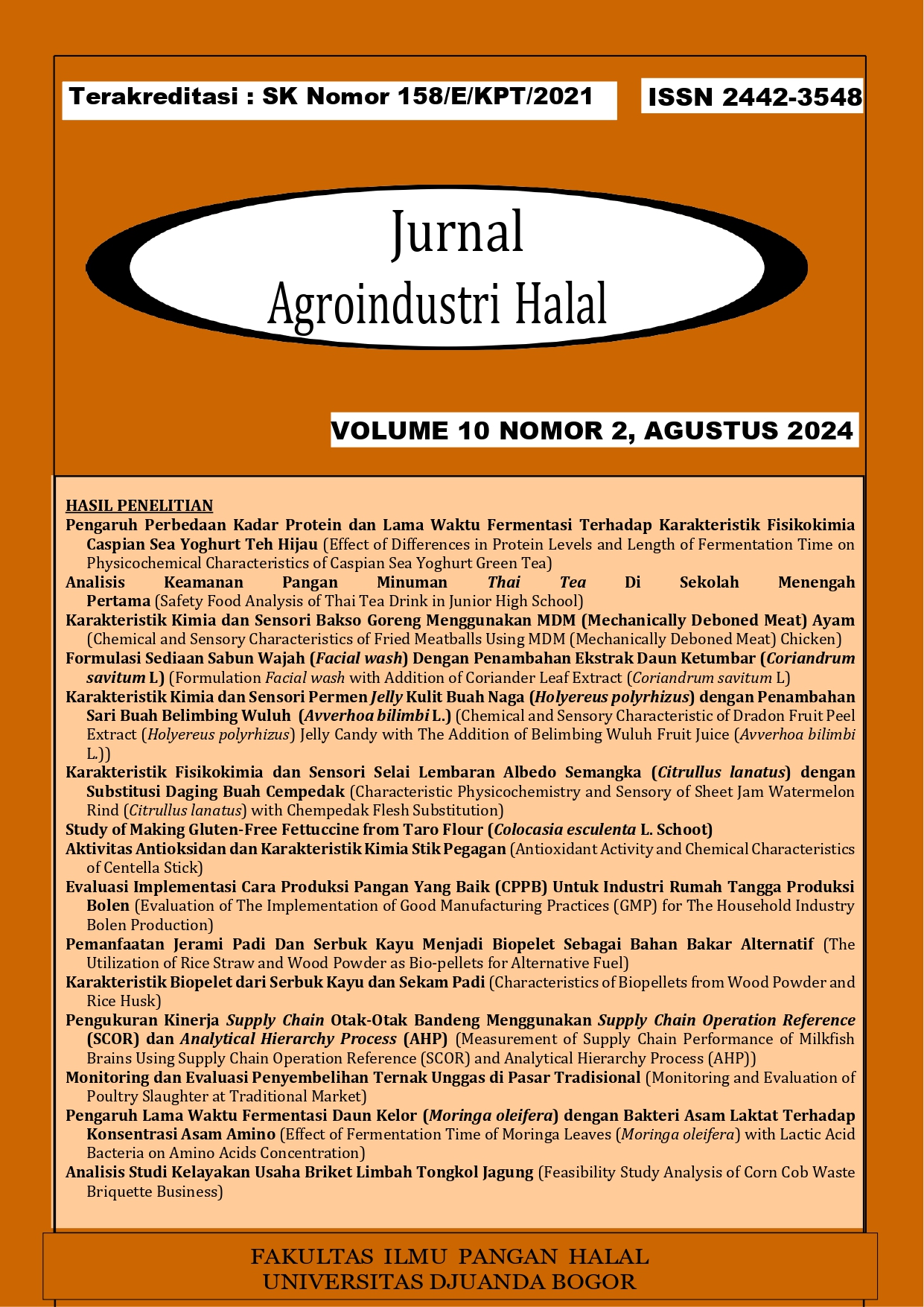Effect of Differences in Protein Levels and Length of Fermentation Time on Physicochemical Characteristics of Caspian Sea Yoghurt Green Tea
DOI:
https://doi.org/10.30997/jah.v10i2.6576Keywords:
Caspian sea yoghurt, fermentation time, green tea powder, protein contentAbstract
Caspian sea inoculum has been widely used for yogurt production, but it is rarely used in making green tea powder (GTP) yoghurt using milk with different protein content. This study aims to determine the changes in the characteristics of GTP yoghurt with Caspian sea inoculum using low fat UHT milk (SLF) or full cream UHT milk (SFC) during the fermentation period at 0 and 16 hours. The results showed that use of different types of UHT milk affected physicochemical characteristics. Fermentation for 16 hours caused a decrease in the pH of the sample to pH 4.3-4.4, but it was negatively correlated with an increase in the acidity. In addition, fermentation resulted increase the value of L* (brightness). The SLF sample has a greener color than the SFC sample. The viscosity of GTP yoghurt increased significantly at 16 hours in SFC and SLF samples. After 16 hours fermentation, the TPC became 4.15 mg GAE/g and 4.45 mg GAE/g with IC50 values of 37.51 g/mL and 23.95 g/mL in SLF and SFC samples. The high protein content in UHT milk affected the high acidity, viscosity, and syneresis values resulting a decrease in the TPC of GTP yoghurt.
References
Abdel-Hamid, M., Huang, Z., Suzuki, T., Enomoto, T., Hamed, A. M., Li, L., & Romeih, E. (2020). Development of a multifunction set yogurt using Rubus suavissimus S. Lee (Chinese Sweet Tea) extract. Foods, 9(9), 1163.
Adrianto, R., Wiraputra, D., Jyoti, M. D., & Andaningrum, A. Z. (2020). Total Bacteria of Lactic Acid, Total Acid, pH Value, Syneresis, Total Dissolved Solids and Organoleptic Properties of Yoghurt Back Slooping Method. Jurnal Agritechno, 13(2), 105–111. https://doi.org/10.20956/at.v13i2.358
Amirdivani, S., & Baba, A. S. H. (2015). Green tea yogurt: major phenolic compounds and microbial growth. Journal of Food Science and Technology, 52(7), 4652–4660. https://doi.org/10.1007/s13197-014-1670-6
Anbukkarasi, K., UmaMaheswari, T., Hemalatha, T., Nanda, D. K., Singh, P., & Singh, R. (2014). Preparation of low galactose yogurt using cultures of Gal+ Streptococcus thermophilus in combination with Lactobacillus delbrueckii ssp. bulgaricus. Journal of Food Science and Technology, 51(9), 2183–2189. https://doi.org/10.1007/s13197-014-1262-5
Bahrami, M., Ahmadi, D., Alizadeh, M., & Hosseini, F. (2013). Physicochemical and sensorial properties of probiotic yogurt as affected by additions of different types of hydrocolloid. Korean Journal for Food Science of Animal Resources, 33(3), 363–368. https://doi.org/10.5851/kosfa.2013.33.3.363
Cabrera, C., Artacho, R., & Giménez, R. (2013). Beneficial Effects of Green Tea—A Review. Journal of the American College of Nutrition, 25(2), 79–99. https://doi.org/10.1080/07315724.2006.10719518
Chen, H., Zheng, H., Brennan, M. A., Chen, W., Guo, X., & Brennan, C. S. (2020). Effect of Black Tea Infusion on Physicochemical Properties, Antioxidant Capacity and Microstructure of Acidified Dairy Gel during Cold Storage. Foods, 9(6). https://doi.org/10.3390/foods9060831
Dönmez, Ö., Mogol, B. A., & Gökmen, V. (2017). Syneresis and rheological behaviors of set yogurt containing green tea and green coffee powders. Journal of Dairy Science, 100(2), 901–907. https://doi.org/10.3168/jds.2016-11262
Fatmawati, U., Prasetyo, F. I., Supia, M. T. ., & Utami, A. N. (2013). KARAKTERISTIK YOGURT YANG TERBUAT DARI BERBAGAIJENIS SUSU DENGAN PENAMBAHAN KULTUR CAMPURANLactobacillus bulgaricus DAN Streptococcus thermophillus. Bioedukasi, 6(2), 1–9. https://media.neliti.com/media/publications/59868-ID-none.pdf
Handayani, K. R. (2021). Pengaruh Komposisi Bakteri pada Yogurt Difortifikasi Buah Jamblang (Syzygium cumini L.) terhadap Karakteristik Organoleptik dan Tingkat Kesukaan Yogurt. Jurnal Ilmiah Pharmacy, 8(1), 27–35. https://doi.org/10.52161/jiphar.v8i1.333
Herlambang, D., Rif’ah, H. I., & Kusnadi, J. (2018). ( KAJIAN PROPORSI PENAMBAHAN SUKROSA DAN SUSU SKIM SERTA JENIS KEDELAI ) Antibacterial Activity Caspian Sea Soyghurt ( Study On Sugar And Skim Milk Proportion And Soybean Varieties ). JFLS, 2(1), 29–44.
Jadid, N., Hidayati, D., Hartanti, S. R., Arraniry, B. A., Rachman, R. Y., & Wikanta, W. (2017). Antioxidant activities of different solvent extracts of Piper retrofractum Vahl. using DPPH assay. AIP Conference Proceedings, 1854(June 2017). https://doi.org/10.1063/1.4985410
Jeong, C. H., Ryu, H., Zhang, T., Lee, C. H., Seo, H. G., & Han, S. G. (2018). Green tea powder supplementation enhances fermentation and antioxidant activity of set-type yogurt. Food Science and Biotechnology, 27(5), 1419–1427. https://doi.org/10.1007/s10068-018-0370-9
Keshavarzi, M., Sharifan, A., & Yasini Ardakani, S. A. (2021). Effect of the ethanolic extract and essential oil of Ferulago angulata (Schlecht.) Boiss. on protein, physicochemical, sensory, and microbial characteristics of probiotic yogurt during storage time. Food Science and Nutrition, 9(1), 197–208. https://doi.org/10.1002/fsn3.1984
Leslie, P. J., & Gunawan, S. (2019). Uji fitokimia dan perbandingan efek antioksidan pada daun teh hijau , teh hitam , dan teh putih ( Camellia sinensis ) dengan metode DPPH ( 2 , 2-difenil-1- pikrilhidrazil ). Tarumanagara Medical Journal, 1(2), 383–388.
Maharani, S., Rahayu, A., Azizah, D. N., Rahayu, D. L., Pendidikan, U., & Bandung, I. (2019). Perbandingan Penambahan Ekstrak Teh pada Karakteristik Kimia Caspian Sea Yoghurt. Jurnal Ilmu Pangan Dan Hasil Pertanian, 3(2), 138–149. https://doi.org/10.26877/jiphp.v3i2.5072
Maharani, S., Sari, N. A., Rahayu, A., Prawira-Atmaja, M. I., & Ana, A. (2020). Physicochemical characteristic of tea infusion yoghurt inoculated with caspian Sea Yoghurt. Sains Malaysiana, 49(12), 2951–2961. https://doi.org/10.17576/jsm-2020-4912-07
Mahmoud Abdel-Hamid 1, 2, , Zizhen Huang 1, T. S. 3, 2, A. M. H., & , Ling Li 1,* and Ehab Romeih 2,*, T. E. 4. (2020). Development of a Multifunction Set Yogurt Using Rubus suavissimus S. Lee (Chinese Sweet Tea) Extract Mahmoud. 1–12.
Muniandy, P., Shori, A. B., & Baba, A. S. (2016). Influence of green, white and black tea addition on the antioxidant activity of probiotic yogurt during refrigerated storage. Food Packaging and Shelf Life, 8, 1–8. https://doi.org/10.1016/j.fpsl.2016.02.002
Muniandy, P., Shori, A. B., & Baba, A. S. (2017). Comparison of the effect of green, white and black tea on Streptococcus thermophilus and Lactobacillus spp. in yogurt during refrigerated storage. Journal of the Association of Arab Universities for Basic and Applied Sciences, 22, 26–30. https://doi.org/10.1016/j.jaubas.2015.11.002
Najgebauer-Lejko, D., Zmudziński, D., Ptaszek, A., & Socha, R. (2014). Textural properties of yogurts with green tea and Pu-erh tea additive. International Journal of Food Science and Technology, 49(4), 1149–1158. https://doi.org/10.1111/ijfs.12411
Purwantiningsih, T. I., Bria, M. A. B., & Kia, K. W. (2022). Kadar protein dan lemak yoghurt yang terbuat dari jenis dan jumlah kultur yang berbeda. 4(1), 66–73.
Ramos, L. R., Santos, J. S., Daguer, H., Valese, A. C., Cruz, A. G., & Granato, D. (2017). Analytical optimization of a phenolic-rich herbal extract and supplementation in fermented milk containing sweet potato pulp. Food Chemistry, 221, 950–958. https://doi.org/10.1016/j.foodchem.2016.11.069
Romero, M. L. M., Staszewski, M. von, & Martínez, M. J. (2021). The effect of green tea polyphenols addition on the physicochemical, microbiological and bioactive characteristics of yogurt. British Food Journal, 123(7), 2380–2397. https://doi.org/10.1108/BFJ-07-2020-0648
Setianto, Y. C., Pramono, Y. B., & Mulyani, S. (2014). Nilai pH , Viskositas , dan Tekstur Yoghurt Drink dengan Penambahan Ekstrak Salak Pondoh ( Salacca zalacca ). Jurnal Aplikasi Teknologi Pangan, 3(3), 110–113.
Setyawardani, E., Rahardjo, D. H. A., & Setyawardani, T. (2021). Pengaruh Jenis Susu Terhadap Sineresis, Water Holding Capacity, Dan Viskositas Yogurt The Effect of Milk Type on Syneresis, Water Holding Capacity, and Yogurt Viscosity. Journal of Animal Science and Technology, 3(3), 242–251.
Świąder, K., Florowska, A., Konisiewicz, Z., & Chen, Y. P. (2020). Functional tea-infused set yoghurt development by evaluation of sensory quality and textural properties. Foods, 9(12), 1–19. https://doi.org/10.3390/foods9121848
Trinovani, E., Prawira-Atmaja, M. I., Kusmiyati, M., Harianto, S., Shabri, & Maulana, H. (2022). Total polyphenols and antioxidant activities of green tea powder from GMB 7 and GMB 9 tea clones. IOP Conference Series: Earth and Environmental Science, 974(1). https://doi.org/10.1088/1755-1315/974/1/012113
Ünal, G., Karagözlü, C., Kinik, Ö., Akan, E., & Akalin, A. S. (2018). Effect of supplementation with green and black tea on microbiological characteristics, antimicrobial and antioxidant activities of drinking Yoghurt. Tarim Bilimleri Dergisi, 24(2), 153–161. https://doi.org/10.15832/ankutbd.446430
Yildirim-Elikoglu, S., & Erdem, Y. K. (2018). Interactions between milk proteins and polyphenols: Binding mechanisms, related changes, and the future trends in the dairy industry. Food Reviews International, 34(7), 665–697. https://doi.org/10.1080/87559129.2017.1377225
Downloads
Published
How to Cite
Issue
Section
License
Copyright (c) 2024 Nabila Khairunnisa Mansoor, Alvin Fajar Iqbal Faturohman, Nabila Sekar Putri, Lili Nailufhar, M Iqbal Prawira-Atmaja, Shinta Maharani, Safitri

This work is licensed under a Creative Commons Attribution-ShareAlike 4.0 International License.
Authors who publish with Jurnal Agroindustri Halal agree to the following terms:
- Authors retain copyright and grant the journal right of first publication with the work simultaneously licensed under a Creative Commons Attribution 4.0 International License that allows others to share the work with an acknowledgement of the work's authorship and initial publication in Jurnal Agroindustri Halal.
- Authors are able to enter into separate, additional contractual arrangements for the non-exclusive distribution of the journal's published version of the work (e.g., post it to an institutional repository or publish it in a book), with an acknowledgement of its initial publication in Jurnal Agroindustri Halal.
- Authors are permitted and encouraged to post their work online (e.g., in institutional repositories or on their website) prior to and during the submission process, as it can lead to productive exchanges, as well as earlier and greater citation of published work









